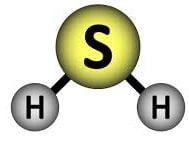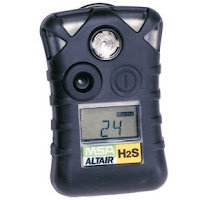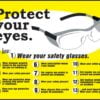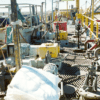Introduction Of Hydrogen sulfide:
Hydrogen sulfide is a gas with the chemical symbol of H2S . one of the extremely toxic and flammable gases on earth. A rotten egg smell is often the first sign of this gas. It can be found anywhere in the oil and gas industries. You may not know you are being exposed to Hydrogen sulfide because it does not have any noticeable color that could warn of its presence inside the body or environment in other words it’s a colorless gas. Hydrogen sulfide gas is produced as a result of the breakdown of organic materials in the absence of oxygen.
Hydrogen sulfide gas has been identified as the most hazardous substance to humans in terms of its properties in relation to human health. This gas can cause breathing problems, headaches, dizziness, and even death at high concentrations. If you’re not careful when working with it then I would be very worried for your life—the air might become unbreathable!
Physical & Chemical Properties of Hydrogen Sulfide
Inorganic material has two hydrogen atoms bonded to one sulfur atom.
Chemical Formula: H2S Molecular Weight: 34.08
- It is generated as an unwanted by-product in operations or
- Produced by bacterial action during decomposition of organic matter.
- It is heavier than air
- Color – colorless
- Odor – similar to that of rotten eggs
- Hydrogen Sulfide kills the sense of smell at dangerous concentrations
- Vapor Density – heavier than air (1.19 compared to 1.0 for air).
- Solubility – Dissolves in water, oil, sludge, emulsions, well fluids, and molten sulfur
- Hazardous Characteristics – Corrosive
- Hydrogen Sulfide dissolves in water to form a weak acid that corrodes and pits metals.
- Toxicity – Extremely poisonous
- Higher concentrations can kill within minutes
- Flammability range:
- LEL=4,3% – UEL=46%.
- Autoignition Temperature = 500°F. Explosive when mixed with air, depending upon proportion.
- Burns with a blue flame
- Burning H2S produces another toxic gas called SO2 (Sulphur Dioxide)

- Sulphur Dioxide (SO2) is a colorless or transparent gas and is non-flammable. It is also heavier than air with a specific gravity of 2.264@0°C.
- SO2 is extremely irritating to the eyes and mucous membranes of the upper respiratory tract. It has exceptionally good warning properties in this regard than H2S.
- Short-term exposures to high levels of sulfur dioxide can be life-threatening.
- Exposure to 100 ppm of sulfur dioxide is considered immediately dangerous to life and health (IDLH)
- Sulfur Dioxide may cause heart problems and respiratory disorders in younger children and elders.
H2S is also known as
- Sulphureted hydrogen
- Devil’s Breath
- Sulfur hydride
- Rotten-egg gas
- Stink Damp
- Sour gas
Measurement:
The “parts per million” or “ppm”* scale is used to measure the concentration of H2S in the area. It divides the total into 1,000,000 parts and tells us, in parts per million, the concentration of the substance we are looking at. The smallest unit we can measure is one part per million.
NOTE: (*) 1% equals 10,000 ppm
Exposure Limits:
TLV-TWA – Threshold Limit Value – Time-Weighted Average :
10 PPM – Limit which is set for exposure to H2S for up to 8 hours per day which results in no short or long-term ill effects.
STEL – Short Term Exposure Limit:
15 PPM – Limit which is set for exposure to H2S for 15 minutes limit 4 times per day with 1 hour between exposures)
IDLH Immediately Dangerous to Life and Health:
33 PPM – Limit which is set for no exposure – Work not allowed if H2S IDLH reach 33 PPM as per KNPC standard
100 PPM – Limit which is set for no exposure – Work not allowed if H2S IDLH reach 100 PPM as per NIOSH standard
Health Effects and Symptoms:
| PPM | Effects / Symptoms |
| 0.13 | Minimum perceptible odor |
| 1* | Easily detectable, moderate odor |
| 10 | The onset of eye irritation |
| 27 | Strong unpleasant odor |
| 100** | Coughing, eye irritation, loss of sense of smell within 2 – 15 minutes |
| 200-300 | Marked eye irritation and inflammation and respiratory tract irritation after a one-hour exposure |
| 500-700 | Loss of consciousness and possibly death in 30-60 minutes |
| 700-1000 | Rapid unconsciousness, respiration stops, death |
| 1000 + | Unconsciousness, death in minutes (3 or less). Death may occur even if rescued |
NOTES:
(*) At 4 – 5 ppm H2S is rapidly detectable by the sense of smell.
(**) At 100 ppm the sense of smell is deadened.
How might I be exposed to hydrogen sulfide?
You can be exposed at work if you work in petroleum refining; wastewater treatment. A small amount of hydrogen sulfide is produced by bacteria in your mouth and gastrointestinal tract and by enzymes in your brain and muscle.
Target organs subject to the effects of H2S:
- Olfactory Nerves
- Lungs
- Eyes
- Brain
Hazards of H2S :
- It is heavier than air hence it always stays in low-lying areas.
- It is an extremely toxic and flammable gas.
- H2S has a Small quantity that smells like “rotten eggs” At low concentration, it paralyzes the olfactory nerve in the nose and destroys the sense of smell temporarily. Do not rely on your sense of smell to detect H2S.
- H2S is Colorless gas, No visible sign of H2S to warn you of its presence
- H2S will enter through the lungs and blocks the transfer of oxygen to the blood cells and causes paralysis of the respiratory system and fatal.
Safety Precautions of H2S:
- adhere to Company safety & health policies & procedures (e.g., PPE, PTW, Risk Assessment )
- Gas testing should be done before starting any job.
- plan and consider hazards and job requirements before beginning work
- Awareness and training should be given to employees.
- Emergency evacuation drills should be conducted.
- Personnel H2S gas monitor shall always be used.
- work in pairs, don’t work alone.
- avoid confined spaces without the provision of the safety requirement and the required training
- stay aware of the wind direction
- consider your escape route in advance and know muster point locations
- respond immediately to emergency alarms and follow instructions if provided.
Engineering controls for hydrogen sulfide
Engineering Controls are another measure OSHA requires your employer to take in ensuring your safety:
- Natural ventilation- comes from normal airflow notes which way windsocks, streamers, and flags are blowing
- Mechanical ventilation-used in confined spaces where only fans and blowers can move the air.
Personal Protection Equipment (PPE) controls
Three types of PPE are used by workers at risk of exposure to H2S:
- Escape Units
- Air-line Units
- SCBA
Respiratory Program
- Fit-testing-ensures that your respiratory equipment is properly adjusted
-
- Do not wear a beard or sideburns
-
- If you wear glasses, get fitted with a facepiece spectacle
- Proficiency drills-will help you know how to wear and use respiratory protection properly
- Maintenance programs- will help ensure that you know how to care for your breathing apparatus
- Medical surveillance-to ensures you do not have a health condition
Safe Operating Practices
- Wind Socks and wind indicators

- Warning Sign
- Fans
- Detectors and monitors maintenance
- Respirators
- Training
Employees in H2S must
- Know how to perform artificial respiration
- Be observant and bring any possibility overlooked hazard or quick change in attitude or physical or mental condition of fellow workers to the attention of the supervisor
- Observe warning signs
- Wear respiratory protection when procedure demands
- Be aware of wind the direction
H2S and Confined Spaces
A few examples of confined space:
Tanks, Vessels, Skirts under vessels, Sumps, Valve pits, Wellhead cellars (onshore E&P), Excavations over 1.2 meters.
Before entering the confined space:
- Ensure you have received the required training related to confined space and Hydrogen Sulphide
- Acquire the necessary PTW and receive the Job Safety Analysis
- Ensure that Gas-Test is performed
- Ensure you are aware of the emergency procedure to be taken in case of needs
- Get all the necessary PPE as breathing apparatus, toxyclips, escape set, etc
- Ensure that stand by man is at the entry of the confined space
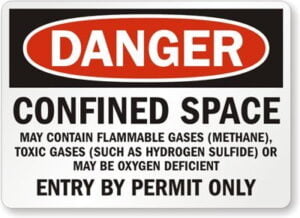
Seven Step Emergency Response Plan
1. EVACUATE
-
- Put on your Escape Mask

- Put on your Escape Mask
-
- Get to a safe area immediately
- Move upwind if release is downwind of you
- Move crosswind if release is upwind of you
2. ALARM
-
- Call for help (“Man Down”)
- Use your radio or telephone to activate ERP and MEDEVAC procedures and alert others
3. ASSESS
-
- Do a headcount

- Consider other hazards
- Do a headcount
4. PROTECT
-
- Emergency Response Team Members will put on breathing apparatus before attempting a rescue
5. RESCUE
-
- Emergency Response Team Members will remove the victim to a safe area
6. REVIVE
-
 Emergency Response Team Members* will apply CPR (Cardio – Pulmonary Resuscitation**) if necessary
Emergency Response Team Members* will apply CPR (Cardio – Pulmonary Resuscitation**) if necessary
- NOTE:(*) CPR can be applied by certified First Aid Team members or by qualified medical personnel. (**) In case of suspected H2S poisoning, CPR must be done with AMBU (ventilation bag) ONLY!
7. MEDICAL AID
-
- Call the Emergency Telephone number

- Arrange transport of victim to medical aid activating MEDEVAC procedure
- Call the Emergency Telephone number
-
- Provide information to emergency medical services
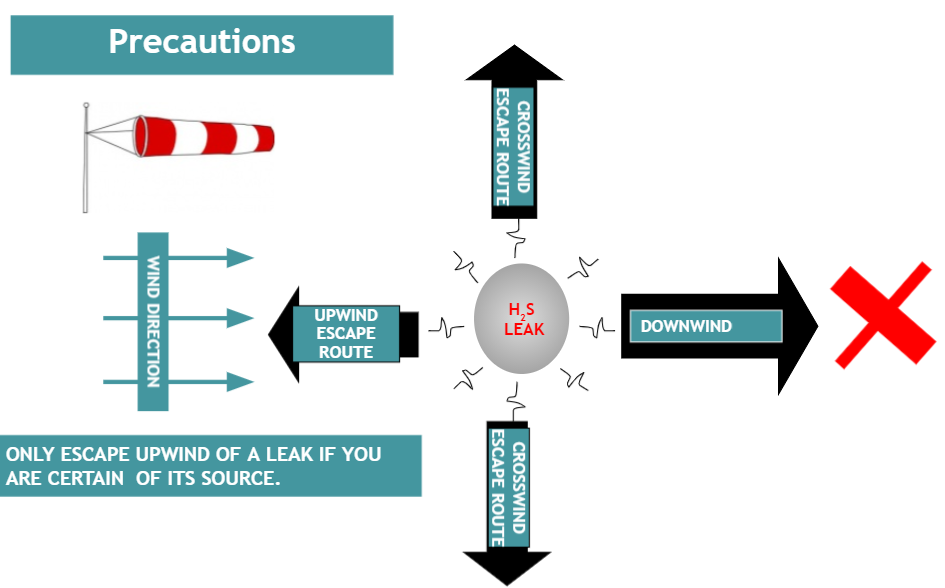
Emergency Rescue Procedures & Basic First Aid
- Do not Panic.
- Call for Help and report to the emergency briefing area.
- Put on full rescue unit (30-minute SCBA) before attempting a rescue.
- Help anyone in distress.
- Remove the victim to fresh air immediately.
- If breathing, maintain victim at rest & administer oxygen if available.
- If not breathing, start CPR immediately.
- Call an ambulance & get the victim’s medical treatment.
- Keep the victim lying down keeping the airway passage open.
- Conserve body heat & do not leave unattended.
- If eyes are affected, wash thoroughly with clean water. Cold compresses may be helpful.
- Victims with minor exposure & not unconscious; send to the doctor to be checked out and not allowed to return to work until the next day.
Remember
- IF YOU TRY TO RESCUE SOMEONE WITHOUT NECESSARY RESPIRATORY EQUIPMENT, YOU WILL BECOME A VICTIM OF THIS DEADLY GAS TOO.
- IF YOU WANT TO HELP THE VICTIM, ASK FOR HELP FROM THE EMERGENCY RESCUE SERVICE.
- DO NOT BE A VICTIM, BE ALIVE!

